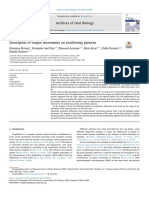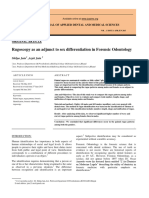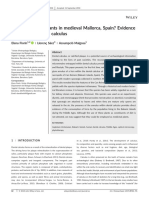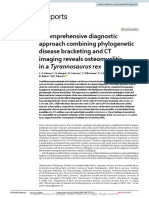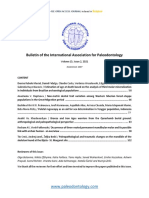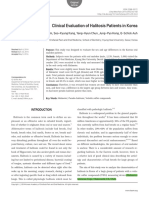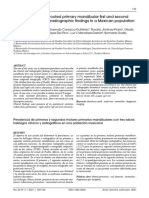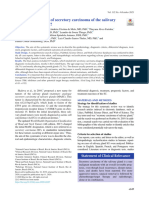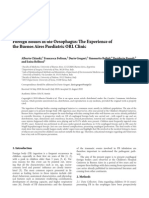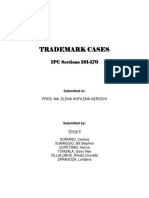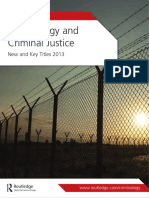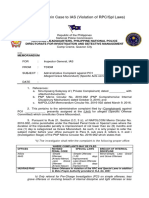Dactyloscopy and Rugos
Dactyloscopy and Rugos
Uploaded by
Jose Li ToCopyright:
Available Formats
Dactyloscopy and Rugos
Dactyloscopy and Rugos
Uploaded by
Jose Li ToOriginal Title
Copyright
Available Formats
Share this document
Did you find this document useful?
Is this content inappropriate?
Copyright:
Available Formats
Dactyloscopy and Rugos
Dactyloscopy and Rugos
Uploaded by
Jose Li ToCopyright:
Available Formats
Original
article
Comparative analysis between dactyloscopy and rugoscopy
Wichnieski, C.1*, Franco, A.2, Igncio, SA.3 and Batista, PS.4
Department of Endodontics, School of Health and Biosciences, Pontifcia Universidade Catlica do Paran PUCPR,
Rua Imaculada Conceio, 1155, Padro Velho, CEP 80215-901, Curitiba, PR, Brazil
2
Forensic Odontology, Department of Oral Health Sciences, Katholieke Universiteit Leuven,
Remi Vandervaerenlaan, 1, 3000, Leuven, Belgium
3
Department of Biostatistics, School of Health and Biosciences, Pontifcia Universidade Catlica do Paran PUCPR,
Rua Imaculada Conceio, 1155, Padro Velho, CEP 80215-901, Curitiba, PR, Brazil
4
Department of Anatomy, School of Health and Biosciences, Pontifcia Universidade Catlica do Paran PUCPR,
Rua Imaculada Conceio, 1155, Padro Velho, CEP 80215-901, Curitiba, PR, Brazil
*E-mail: carol_wsich@hotmail.com
1
Abstract
Records form the evolutional history show primitive attempts of human individualization by hand printing
on cave walls. Later, still under the need of differentiating among other animals, the ancestral used developed
processes for personal identification. Nowadays, the human individualization continues based on unique
morphological characteristics. This study aims to analyze the correlation between the fingerprints and the
palatal rugae. A sample of 93 patients, out of 100, aged between 18 and 35 years, was selected. Fingerprints
were collected by impression on paper, and palatal rugae were registered through intra-oral photography.
The Vucetichs method was applied for the fingerprints analysis and the Carreas method was utilized for the
analysis on palatal rugae. Frequency of distribution was applied to describe the incidence of fingerprints and
palatal rugae patterns. The Chi-square test was used for correlation analysis between the two variables. The
external clip was the most common pattern among fingerprints on the right hand (48,39%), on the opposite
side the internal clip had major incidence (50,54%). The pattern type IV was observed as the most common
among the palatal rugae (42,55%). The Chi-square test demonstrated significant result only when correlated
right and left hands. No statistical correlation was found involving palatal rugae. It is possible to conclude
that genetic intervention is the main factor to explain relevant results on correlations between opposite hands.
Considering the absence of previous studies in the literature, this research aims to provide initial support for
further investigations.
Keywords: anatomy, fingerprints, identification, morphology, palatal rugae.
1 Introduction
Several history remains were found in the last decades.
Valuable findings are observed in places occupied by primitive
groups. Examples of the human evolution are the hand prints
on cave walls, which are considered registers of time (ELKIN,
1952). During ancient periods the individualization process
became important among the other animals. Consequently,
the ancestral began to implement different techniques for self
identification such as hand impressions on fresh clay. These
attitudes were the pioneer signs of interest on morphological
features (PERANDRA and PERANDRA-JUNIOR,
2006). After the organization of groups into societies, the
needs for individualization became more evident. In order to
provide proper differentiations, distinct attempts for personal
identification were tested (SCHMIDT, 1999; COTRIM and
JAIME, 2007). Nowadays, the most common techniques
for accessing personal identity are based on morphology
(PERANDRA and PERANDRA-JUNIOR, 2006). The
most common methods for data collection are related to
anthropometric (BERAR, TILOTTA, GLAUNES et al.,
2011) photographic (HEMANTH, VIDYA, SHETTYetal.,
2010), and radiographic acquisition (NUZZOLESE and
DIVELLA, 2012).
The morphological sciences have demonstrated that
many anatomic features can be representative to differentiate
174
individuals (PALIWAL, WANJARI and PARWANI, 2010).
The fingerprints and the palatal rugae are broadly used because
of its feasibility and accuracy, which are matters of relevance
for practical usefulness. Dactyloscopy (PERANDRA and
PERANDRA-JUNIOR, 2006) and rugoscopy (CAMPOS,
2008; CALABIUG, 1998) are the names given to the study
of fingerprints and palatal rugae respectively. Both systems
for personal identification are characterized by the criteria
of durability, immutability and individuality (CALDAS,
MAGALHES and AFONSO, 2007). The aim of this study
is to verify possible correlations between the fingerprints and
the palatal rugae.
2 Material and methods
The initial sample consisted of 100 individuals, aged
between 18 and 35 years, and examined at the Pontifcia
Universidade Catlica do Paran, Brazil. Individuals with
dermatologic alterations, systemic diseases and/or deep
palate were removed from the study. The final sample
consisted of 94 individuals, 72 females and 21 males. All the
examined participants received previous information about
the study and signed an informed consent.
J. Morphol. Sci., 2012, vol. 29, no. 3, p. 174-177
Comparative analysis between dactyloscopy and rugoscopy
Aiming the dactyloscopy analysis the left and right thumbs
were selected. The collection of fingerprints was performed
by impression on paper using the Black pigment Ink-Perfect
Ink (Perfect Ink, California, USA). The palatal rugae was
accessed and registered digitaly (Figure 1) by using the
Gnatus intraoral microcamera InCam LX (Gnatus, So
Paulo, Brazil). In order to manipulate contrasts and generate
a better imaging quality, the palatal pictures were added into
the software Adobe Photoshop CS5 (Adobe Systems,
Califrnia, USA).
The fingerprints were categorized according to the
classification of Vucetich (VUCETICH, 1904), which
divides the fingerprints into 4 main groups: 1) Arch; 2)
Internal Clip; 3) External Clip; and 4) Verticil (Figure 2).
The palatal rugae were organized into 4 different groups,
named I, II, III, and IV according to Carreas classification
(CARREA, 1937) (Figure3).
Figure 1. Picture of palatal rugae obtained with the intraoral
microcamera.
2.1 Statistical analysis
The variables left thumb, right thumb and palatal rugae
were analyzed by frequency of distribution. In order to
verify possible correlation between the variables gender, left
thumb, right thumb, and palatal rugae were considered and
the Chi-square test was applied. Chi-square test is the most
used method for data comparison in a categorical nominal
scale (ARANGO, 2009). Through this method the analysis
is made based on the existence of dependency between the
variables under observation (VIEIRA, 2003).
3 Results
The most common pattern for the fingerprints of the
right thumb was the External Clip corresponding to 47,87%
of the cases. Verticil, Arch, and Internal Clip were observed
in 42,55%, 7,44%, and 2,12% of the sample, respectively. The
left thumb showed the Internal Clip as the most frequent
pattern, present in 50,00% of the individuals. Verticil, Arch,
and External Clip were represented in 35,10%, 11,70%,
and 3,19% respectively. Among the palatal rugae, the
arrangement type IV was found in major scale, 42,55% of the
cases. Palatal rugae type II, I, and III were represented by
35,11%, 17,02%, and 5,32% of the individuals respectively.
The gender distribution was divided in 23,40% of males and
76,60% of females. Table1 represents the distribution of the
variable on frequency values.
The statistical analysis did not show relevant significance
between the palatal rugae and the fingerprints (p > 0,05).
No statistical significance was observed when correlated
the variable gender to the other variables (p > 0,05). A
significant correlation between left and right thumbs was
observed through the Qui-square test (p = 0,000).
4 Discussion
Vucetichs classification for fingerprints and Carreas
classification for palatal rugae were addressed in this
study regarding the broad use of these techniques in
southAmerican researches. The advantage of using the
mentioned classifications is related to the fact that both were
derived from the same region of the sample used in this
Figure 2. Arrangements of fingerprints according to Vucetichs
classification. The arrangements are divided into: Arch; Internal
Clip; External Clip; and Verticil. Addapted from: Dactiloscopia.
Londrina PR: GE Idealiza. 2006.
Table 1. Distribution of variables represented on frequency
values.
Variables
1. Right Thumb
2. Left Thumb
3. Palatal Rugae
Figure 3. Arrangements of palatal rugae according to Carreas
classification. The arrangements are divided into: Type I; II; III;
and IV. Addapted from: Compndio de Odontologia Legal. So
Paulo, SP: Medsi. 1997.
J. Morphol. Sci., 2012, vol. 29, no. 3, p. 174-177
4. Gender
Classification
1.1 Arch
1.2 Internal Clip
1.3 External Clip
1.4 Verticil
2.1 Arch
2.2 Internal Clip
2.3 External Clip
2.4 Verticil
3.1 I
3.2 II
3.3 III
3.4 IV
4.1 Male
4.2 Female
Frequency
7
2
45
40
11
47
3
33
16
33
5
40
22
72
175
Wichnieski, C., Franco, A., Igncio, SA. et al.
research. The main objection in the use of these classifications
is the lack of experiments found in other continents, which
trend the discussion to south-American publications.
The use of fingerprints and palatal rugae, as
morphological patterns in this study, is justified by the utility
and feasibility that these identity indicators have nowadays
(NAYAKI, ACHARYA and KAVERI, 2007; HEMANTH,
VIDYA, SHETTY et al., 2010). The same reason explains
the selection of only left and right thumbs for fingerprint
collection. In some of the south-American countries the
identity cards of civilians present a single fingerprint of the
right thumb (VALID, 2012). The collection of palatal rugae
as a document is also applied in south-American countries.
Some authors consider the palatal rugae an identification
tool equivalent to the fingerprints (PALIWAL, WANJARI
and PARWANI, 2010; ENGLISH, ROBINSON,
SUMMITetal., 1988; NAYAKI, ACHARYA and KAVERI,
2007; MARCO, PHILIPS, KULAetal., 1995). In Brazil,
for example, the palatal impressions are collect from the pilots
of the Brazilian Air Force in order to facilitate identification
cases (CALDAS, MAGALHES and AFONSO, 2007).
Considering the statistical analysis, the simple frequency
of distribution demonstrated that the most frequent
fingerprint pattern, according to the Vucetichs classification,
is the External Clip for the right thumb and the Internal Clip
for the left thumb. On the other hand, Holt indicates the
Verticil as the most common pattern for both hands (HOLT,
1955). Despite that, the Verticil was observed as the second
most common pattern for right and left thumbs.
The palatal rugae type IV, according to Carreas
classification, was the most common pattern among the
individuals analyzed. Unfortunately, there is no other study
with the same classification found in the literature to support
or contrast this finding.
The absence of correlation between the fingerprints and
palatal rugae, demonstrated by the Chi-square test, shows
that no dependency is verified between the variables. The
absence of correlation between the gender and the palatal
rugae also represents no dependency between the variables,
and it is confirmed by previous studies (SIMMONS,
MOORE and ERICKSON, 1987; KASHIMA, 1990).
The straight correlation observed between left and right
thumbs can be explained by the genetic intervention during
the dermatoglyphic formation (FRASER and NORA,
1988). Dermatoglyphs is the name given to the several
components of the fingerprints and it has a polygenic
genetic origin, which means that the fingerprints patterns
are determined by the action of different genes spread
in the human cells (SALDANHA, 1968; TOLEDO,
SALDANHA, LAURENTI et al., 1969). Additional
examples of the genetic intervention during the fingerprints
formation are found on studies which demonstrate that
syndromes such as Down (FRASER and NORA, 1988),
and dermatological diseases such as Psoriasis and Vitiligo are
represented by similar fingerprint arrangements (KUMAR
and GUPTA, 2010). The genetics influence during the
morphological formation is also the most accepted answer
for the differences on palatal rugae arrangement. Most of the
studies based on this concept were performed on population
trials (KAPALI, TOWNSEND, RICHARD et al., 1997);
(HAUSER, DAPONTE and ROBERTS, 1989; THOMAS
and KOTZE, 1983). Thomas and Kotze explains that, by
176
the genetic factor, even when palatal patterns discriminate
individuals from certain region, if distinct individual from
the same region but out of the original sample were taken,
the results could be different (THOMAS and KOTZE,
1983). The mentioned explanation support the fact that, in
the present study, both fingerprint and palatal rugae are not
correlated to each other, neither to the gender.
5 Conclusion
No statistical significance was observed between the
fingerprints and the palatal rugae. The gender is not
associated with the frequency of specific fingerprints or
palatal rugae. Significant statistical result was obtained by
the correlation between right and left thumbs fingerprints.
The limitation of establishing a comparative analysis
without similar researches made difficult the methodological
discussion. More studies on the present classifications must
be performed in order to improve the literature support.
Yet, the informative profile of the present paper benefits the
methodological approach for further investigations.
Acknowledgements: The authors would like to express gratitude
to the Pontificia Universidade Catlica do Paran for the one-year
scholarship during this research.
References
ARANGO, HG. Bioestatstica terica e computacional.3.ed. Rio de
Janeiro: Guanabara Koogan,2009.
BERAR, M., TILOTTA, FM., GLAUNES, JA. and ROZENHOLC,
Y. Craniofacial reconstruction as a predicton problem using a latent
root regression model. Forensic Science International,2011, vol.210,
p.228-36. http://dx.doi.org/10.1016/j.forsciint.2011.03.010
CALABIUG, JAG. Medicina legal y toxicologia. 5. ed. Barcelon:
Masson,1998.
CALDAS, IM., MAGALHES, T. and AFONSO, A.
Establishing identity using cheiloscopy and palatoscopy. Forensic
Science International, 2007, vol. 165, p. 1-9. http://dx.doi.
org/10.1016/j.forsciint.2006.04.010
CAMPOS, MLB. Rugoscopia Palatina. In VANRELL, JP.
Odontologia Legal & Antropologia Forense. 2. ed. Rio de Janeiro:
Guanabara Koogan,2008.
CARREA, JU. La identificacion humana por las rugosidades
palatinas. Revista Ortodontia,1937, vol.1, p.3-23.
COTRIM, G. and JAIME, R. Saber e fazer histria. 4. ed. So
Paulo: Saraiva,2007.
ELKIN, AP. Cave-painting in the southern Arnhem Land.
Oceania,1952, vol.22, n.4, p.245-55.
ENGLISH, WR., ROBINSON, SF., SUMMIT, JB., OESTRELE,
LJ., BRANNON, RB. and MORLANG, WM. Individuality of
human palatal rugae. Journal of Forensic Sciences, 1988, vol. 33,
p.718-26.
FRASER, FC. and NORA, JJ. Gentica Humana. 2. ed. Rio de
Janeiro: Guanabara,1988.
HAUSER, G., DAPONTE. A. and ROBERTS, MJ. Palatal rugae.
Journal of Anatomy,1989, vol.165, p.237-249.
HEMANTH, M., VIDYA, M., SHETTY, N. and KARKERA,
BV. Identification of individual using palatal rugae: computerized
method. Journal of Forensic Dental Science,2010, vol.2, p.86-90.
http://dx.doi.org/10.4103/0975-1475.81288
J. Morphol. Sci., 2012, vol. 29, no. 3, p. 174-177
Comparative analysis between dactyloscopy and rugoscopy
HOLT, SB. Genetics of dermal ridges: frequency distributions of
total finger ridge count. Annals of Human Genetics,1955, vol.20,
p. 159-173.
http://dx.doi.org/10.1111/j.1469-1809.1955.
tb01365.x
KAPALI, S., TOWNSEND, G., RICHARD, L. and PARISH,
T. Palatal rugae patterns in australian aborigines and caucasians.
Australian Dental Journal, 1997, vol. 42, p. 129-33. http://
dx.doi.org/10.1111/j.1834-7819.1997.tb00110.x
KASHIMA, K. Comparative study of the palatal rugae and the shape
of the hard palate in Japanese and Indian children. Aichi Gakuin
Daigaku Shigakkai Shi,1990, vol.28, p.295-320.
KUMAR, P. and GUPTA, A. Dermatoglyphic patterns in psoriasis,
vitiligo and alopecia areata. Indian Journal of Dermatology,
Venereology and Leprology,2010, vol.76, p.185-86. http://dx.doi.
org/10.4103/0378-6323.60556
MARCO, AA., PHILIPS, C., KULA, K. and TULLOCH, C.
Stability of palatal rugae as landmarks for analysis of dental cast.
Angle Orthodontist,1995, vol.65, p.43-48.
NAYAKI, P., ACHARYA, AB. and KAVERI, H. Differences in the
palatal rugae shape in two population of India. Archives of Oral
Biology, 2007, vol. 52, p. 977-82. http://dx.doi.org/10.1016/j.
archoralbio.2007.04.006
NUZZOLESE, E. and DI VELLA, G. Digital radiological
research in forensic dental investigations: case studies. Minerva
Stomatologica,2012, vol.61, n.4, p.165-173.
PALIWAL, A., WANJARI, S. and PARWANI, R. Palatal rugoscopy:
Establishing identity. Journal of Forensic Dental Sciences,2010, vol.2,
n.1, p.27-31. http://dx.doi.org/10.4103/09742948.71054
J. Morphol. Sci., 2012, vol. 29, no. 3, p. 174-177
PERANDRA, CA. and PERANDRA-JUNIOR, CA. Datiloscopia.
Londrina: GE Idealiza,2006.
SALDANHA, PH. Dermatglifos em Gentica Mdica. Revista
paulista de Medicina,1968, vol.72, n.4, p.173-204.
SCHMIDT, MF. Nova histria crtica. So Paulo: Nova
Gerao,1999.
SIMMONS, JD., MOORE, RN. and ERICKSON, LC. A
longitudinal study of the anteroposterior growth changes in palatal
rugae. Journal of Dental Research,1987, vol.6, n.9, p.1512-115.
TOLEDO, SPA., SALDANHA, SG., LAURENTI, R. and
SALDANHA, PH. Dermatglifos digitais e palmares de
indivduos normais da populao de So Paulo. Revista paulista de
Medicina,1969, vol.75, p.1-10.
THOMAS, CJ. and KOTZE, TJ. The palatal rugae pattern: A new
classification. Journal of Dental Association of South Africa, 1983,
vol.38, p.153-7.
VALID. Sistema de Identificao no DF modelo no pas. [on-line].
Available
from:
<http://www.valid.com.br/noticias/sistemaidentificacao-no-df-modelo-no-pais>. Access in:2012/03/22.
VIEIRA, SM. Bioestatstica: tpicos avanados. So Paulo:
Campus,2003.
VUCETICH, J. Dactiloscopia comparada. La Plata: Jacobo
Peuser,1904.
Received March 23, 2012
Accepted September 17, 2012
177
You might also like
- Description of Tongue Movements On Swallowing Patterns Articulo 2No ratings yetDescription of Tongue Movements On Swallowing Patterns Articulo 26 pages
- 11 - Facts and Myths Regarding The Maxillary Midline Frenum and Its Treatment A Systematic Review of The Literature100% (1)11 - Facts and Myths Regarding The Maxillary Midline Frenum and Its Treatment A Systematic Review of The Literature11 pages
- Root Canal Morphology of 1316 Premolars From Brazilian Individuals: An in Vivo Analysis Using Cone-Beam Computed TomographyNo ratings yetRoot Canal Morphology of 1316 Premolars From Brazilian Individuals: An in Vivo Analysis Using Cone-Beam Computed Tomography6 pages
- 5 Rugoscopy As An Adjunct To Sex Differentiation in Forensic OdontologyNo ratings yet5 Rugoscopy As An Adjunct To Sex Differentiation in Forensic Odontology5 pages
- Worldwide Anatomic Characteristics of The MandibulNo ratings yetWorldwide Anatomic Characteristics of The Mandibul16 pages
- Assessment of Upper and Lower Pharyngeal Airway Width in Skeletal Class I, II and III MalocclusionsNo ratings yetAssessment of Upper and Lower Pharyngeal Airway Width in Skeletal Class I, II and III Malocclusions8 pages
- A Method For Epidemiological Registration of MalocclusionNo ratings yetA Method For Epidemiological Registration of Malocclusion2 pages
- Dermatoglyphics and Malocclusion - Are They Related ?: Manuscript InfoNo ratings yetDermatoglyphics and Malocclusion - Are They Related ?: Manuscript Info7 pages
- Ferns As Healing Plants in Medieval Mallorca, Spain? Evidence From Human Dental CalculusNo ratings yetFerns As Healing Plants in Medieval Mallorca, Spain? Evidence From Human Dental Calculus9 pages
- One Step Forward: Contrasting The Effects of Toe Clipping and PIT Tagging On Frog Survival and Recapture ProbabilityNo ratings yetOne Step Forward: Contrasting The Effects of Toe Clipping and PIT Tagging On Frog Survival and Recapture Probability11 pages
- Two Interceptive Approaches To Palatally Displaced Canines - A Prospective Longitudinal StudyNo ratings yetTwo Interceptive Approaches To Palatally Displaced Canines - A Prospective Longitudinal Study6 pages
- Cephalometric Norms From Posteroanterior Ricketts' Cephalograms From Hispanic American Peruvian Non Adult PatientsNo ratings yetCephalometric Norms From Posteroanterior Ricketts' Cephalograms From Hispanic American Peruvian Non Adult Patients8 pages
- Kiani - Etical Considerations in Animal ExperimentationNo ratings yetKiani - Etical Considerations in Animal Experimentation12 pages
- Early Orthodontic Treatment of Skeletal Open-Bite MalocclusionNo ratings yetEarly Orthodontic Treatment of Skeletal Open-Bite Malocclusion7 pages
- Non-Nutritive Sucking Habits, Dental Malocclusions, and Facial Morphology in Brazilian Children: A Longitudinal StudyNo ratings yetNon-Nutritive Sucking Habits, Dental Malocclusions, and Facial Morphology in Brazilian Children: A Longitudinal Study6 pages
- Altarelli Et Al (2014) Dyslexia and Planun TemporalNo ratings yetAltarelli Et Al (2014) Dyslexia and Planun Temporal19 pages
- A Comprehensive Diagnostic Approach Combining PhylNo ratings yetA Comprehensive Diagnostic Approach Combining Phyl17 pages
- General Assumption of Psychological Behavior Based On Finger Print PatternNo ratings yetGeneral Assumption of Psychological Behavior Based On Finger Print Pattern7 pages
- Efficiency of ODI and APDI of Kim's Cephalometric Analysis in A Latin American Population With Skeletal Open BiteNo ratings yetEfficiency of ODI and APDI of Kim's Cephalometric Analysis in A Latin American Population With Skeletal Open Bite9 pages
- 05-Is Measurement of The Gingival Biotype ReliableNo ratings yet05-Is Measurement of The Gingival Biotype Reliable6 pages
- Correlation of Dermatoglyphics and Class II Skeletal Malocclusion - Original ResearchNo ratings yetCorrelation of Dermatoglyphics and Class II Skeletal Malocclusion - Original Research5 pages
- Examining Secondary School Students' Misconceptions About The Human Body: Correlations Between The Methods of Drawing and Open-Ended QuestionsNo ratings yetExamining Secondary School Students' Misconceptions About The Human Body: Correlations Between The Methods of Drawing and Open-Ended Questions9 pages
- Mediterranean and western dietary patterns are related to markers of testicular function among healthy menNo ratings yetMediterranean and western dietary patterns are related to markers of testicular function among healthy men11 pages
- Clinical Evaluation of Halitosis Patients in KoreaNo ratings yetClinical Evaluation of Halitosis Patients in Korea6 pages
- Craniofacial Asymmetry in Development: An Anatomical StudyNo ratings yetCraniofacial Asymmetry in Development: An Anatomical Study5 pages
- Rugas Palatales para Investigación ForenseNo ratings yetRugas Palatales para Investigación Forense5 pages
- A Systematic Review of Secretory Carcinoma of The Salivary Gland: Where Are We?No ratings yetA Systematic Review of Secretory Carcinoma of The Salivary Gland: Where Are We?10 pages
- Research Article: Foreign Bodies in The Oesophagus: The Experience of The Buenos Aires Paediatric ORL ClinicNo ratings yetResearch Article: Foreign Bodies in The Oesophagus: The Experience of The Buenos Aires Paediatric ORL Clinic7 pages
- Cephalometric Features of Filipinos With Angle Class I Oclussion According To The Munich AnalysisNo ratings yetCephalometric Features of Filipinos With Angle Class I Oclussion According To The Munich Analysis6 pages
- Cheiloscopy: Study of Lip Prints in Establishing Identity of An IndividualNo ratings yetCheiloscopy: Study of Lip Prints in Establishing Identity of An Individual5 pages
- Techniques for Genetic Analysis of Non Syndromal Cleft Lip/Palate: A ReviewNo ratings yetTechniques for Genetic Analysis of Non Syndromal Cleft Lip/Palate: A Review6 pages
- Three Dimensional Assesment of Pharyngeal Airway in Nasal and Mouthbreathing Children Alves Int Jour Ped Otorhino 2011 1No ratings yetThree Dimensional Assesment of Pharyngeal Airway in Nasal and Mouthbreathing Children Alves Int Jour Ped Otorhino 2011 15 pages
- R.A. No. 8294 - Illegal Possession of Firearm: 12:10 AM Criminal Law Law Primer 4No ratings yetR.A. No. 8294 - Illegal Possession of Firearm: 12:10 AM Criminal Law Law Primer 43 pages
- ARIAS DOCTRINE (Initial Signature of Subordinates)No ratings yetARIAS DOCTRINE (Initial Signature of Subordinates)1 page
- Referral of Admin Case To IAS (Violation of RPC/SPL Laws)No ratings yetReferral of Admin Case To IAS (Violation of RPC/SPL Laws)2 pages
- Analysis of Power System Stability of A Hybrid Microgrid For On-Grid and Off-Grid Operation by Using ETAP SoftwareNo ratings yetAnalysis of Power System Stability of A Hybrid Microgrid For On-Grid and Off-Grid Operation by Using ETAP Software8 pages
- Bank Soal Bahasa Inggris (Degree of Comparison) - Quizizz100% (1)Bank Soal Bahasa Inggris (Degree of Comparison) - Quizizz7 pages
- Wins Monitoring System - Dagumbaan Integrated SchoolNo ratings yetWins Monitoring System - Dagumbaan Integrated School17 pages
- U.S. Marines in Iraq 2003 Anthology and Annotated Bibliography100% (3)U.S. Marines in Iraq 2003 Anthology and Annotated Bibliography359 pages
- Mathcounts 2015-16 School Level - Sprint RoundNo ratings yetMathcounts 2015-16 School Level - Sprint Round6 pages
- The Challenge of Organizational Communication PDFNo ratings yetThe Challenge of Organizational Communication PDF12 pages
- ENGLISH PRE AARAMBH CHECKLIST BY NIMISHA MAM 2 NOV 2023 DocxNo ratings yetENGLISH PRE AARAMBH CHECKLIST BY NIMISHA MAM 2 NOV 2023 Docx8 pages
- Manual of High Resolution Esophageal ManometryFrom EverandManual of High Resolution Esophageal Manometry
- Description of Tongue Movements On Swallowing Patterns Articulo 2Description of Tongue Movements On Swallowing Patterns Articulo 2
- 11 - Facts and Myths Regarding The Maxillary Midline Frenum and Its Treatment A Systematic Review of The Literature11 - Facts and Myths Regarding The Maxillary Midline Frenum and Its Treatment A Systematic Review of The Literature
- Root Canal Morphology of 1316 Premolars From Brazilian Individuals: An in Vivo Analysis Using Cone-Beam Computed TomographyRoot Canal Morphology of 1316 Premolars From Brazilian Individuals: An in Vivo Analysis Using Cone-Beam Computed Tomography
- 5 Rugoscopy As An Adjunct To Sex Differentiation in Forensic Odontology5 Rugoscopy As An Adjunct To Sex Differentiation in Forensic Odontology
- Worldwide Anatomic Characteristics of The MandibulWorldwide Anatomic Characteristics of The Mandibul
- Assessment of Upper and Lower Pharyngeal Airway Width in Skeletal Class I, II and III MalocclusionsAssessment of Upper and Lower Pharyngeal Airway Width in Skeletal Class I, II and III Malocclusions
- A Method For Epidemiological Registration of MalocclusionA Method For Epidemiological Registration of Malocclusion
- Dermatoglyphics and Malocclusion - Are They Related ?: Manuscript InfoDermatoglyphics and Malocclusion - Are They Related ?: Manuscript Info
- Ferns As Healing Plants in Medieval Mallorca, Spain? Evidence From Human Dental CalculusFerns As Healing Plants in Medieval Mallorca, Spain? Evidence From Human Dental Calculus
- One Step Forward: Contrasting The Effects of Toe Clipping and PIT Tagging On Frog Survival and Recapture ProbabilityOne Step Forward: Contrasting The Effects of Toe Clipping and PIT Tagging On Frog Survival and Recapture Probability
- Two Interceptive Approaches To Palatally Displaced Canines - A Prospective Longitudinal StudyTwo Interceptive Approaches To Palatally Displaced Canines - A Prospective Longitudinal Study
- Cephalometric Norms From Posteroanterior Ricketts' Cephalograms From Hispanic American Peruvian Non Adult PatientsCephalometric Norms From Posteroanterior Ricketts' Cephalograms From Hispanic American Peruvian Non Adult Patients
- Kiani - Etical Considerations in Animal ExperimentationKiani - Etical Considerations in Animal Experimentation
- Early Orthodontic Treatment of Skeletal Open-Bite MalocclusionEarly Orthodontic Treatment of Skeletal Open-Bite Malocclusion
- Non-Nutritive Sucking Habits, Dental Malocclusions, and Facial Morphology in Brazilian Children: A Longitudinal StudyNon-Nutritive Sucking Habits, Dental Malocclusions, and Facial Morphology in Brazilian Children: A Longitudinal Study
- Altarelli Et Al (2014) Dyslexia and Planun TemporalAltarelli Et Al (2014) Dyslexia and Planun Temporal
- A Comprehensive Diagnostic Approach Combining PhylA Comprehensive Diagnostic Approach Combining Phyl
- General Assumption of Psychological Behavior Based On Finger Print PatternGeneral Assumption of Psychological Behavior Based On Finger Print Pattern
- Efficiency of ODI and APDI of Kim's Cephalometric Analysis in A Latin American Population With Skeletal Open BiteEfficiency of ODI and APDI of Kim's Cephalometric Analysis in A Latin American Population With Skeletal Open Bite
- 05-Is Measurement of The Gingival Biotype Reliable05-Is Measurement of The Gingival Biotype Reliable
- Correlation of Dermatoglyphics and Class II Skeletal Malocclusion - Original ResearchCorrelation of Dermatoglyphics and Class II Skeletal Malocclusion - Original Research
- Examining Secondary School Students' Misconceptions About The Human Body: Correlations Between The Methods of Drawing and Open-Ended QuestionsExamining Secondary School Students' Misconceptions About The Human Body: Correlations Between The Methods of Drawing and Open-Ended Questions
- Mediterranean and western dietary patterns are related to markers of testicular function among healthy menMediterranean and western dietary patterns are related to markers of testicular function among healthy men
- Clinical Evaluation of Halitosis Patients in KoreaClinical Evaluation of Halitosis Patients in Korea
- Craniofacial Asymmetry in Development: An Anatomical StudyCraniofacial Asymmetry in Development: An Anatomical Study
- A Systematic Review of Secretory Carcinoma of The Salivary Gland: Where Are We?A Systematic Review of Secretory Carcinoma of The Salivary Gland: Where Are We?
- Research Article: Foreign Bodies in The Oesophagus: The Experience of The Buenos Aires Paediatric ORL ClinicResearch Article: Foreign Bodies in The Oesophagus: The Experience of The Buenos Aires Paediatric ORL Clinic
- Cephalometric Features of Filipinos With Angle Class I Oclussion According To The Munich AnalysisCephalometric Features of Filipinos With Angle Class I Oclussion According To The Munich Analysis
- Cheiloscopy: Study of Lip Prints in Establishing Identity of An IndividualCheiloscopy: Study of Lip Prints in Establishing Identity of An Individual
- Techniques for Genetic Analysis of Non Syndromal Cleft Lip/Palate: A ReviewTechniques for Genetic Analysis of Non Syndromal Cleft Lip/Palate: A Review
- Three Dimensional Assesment of Pharyngeal Airway in Nasal and Mouthbreathing Children Alves Int Jour Ped Otorhino 2011 1Three Dimensional Assesment of Pharyngeal Airway in Nasal and Mouthbreathing Children Alves Int Jour Ped Otorhino 2011 1
- R.A. No. 8294 - Illegal Possession of Firearm: 12:10 AM Criminal Law Law Primer 4R.A. No. 8294 - Illegal Possession of Firearm: 12:10 AM Criminal Law Law Primer 4
- ARIAS DOCTRINE (Initial Signature of Subordinates)ARIAS DOCTRINE (Initial Signature of Subordinates)
- Referral of Admin Case To IAS (Violation of RPC/SPL Laws)Referral of Admin Case To IAS (Violation of RPC/SPL Laws)
- Analysis of Power System Stability of A Hybrid Microgrid For On-Grid and Off-Grid Operation by Using ETAP SoftwareAnalysis of Power System Stability of A Hybrid Microgrid For On-Grid and Off-Grid Operation by Using ETAP Software
- Bank Soal Bahasa Inggris (Degree of Comparison) - QuizizzBank Soal Bahasa Inggris (Degree of Comparison) - Quizizz
- Wins Monitoring System - Dagumbaan Integrated SchoolWins Monitoring System - Dagumbaan Integrated School
- U.S. Marines in Iraq 2003 Anthology and Annotated BibliographyU.S. Marines in Iraq 2003 Anthology and Annotated Bibliography
- ENGLISH PRE AARAMBH CHECKLIST BY NIMISHA MAM 2 NOV 2023 DocxENGLISH PRE AARAMBH CHECKLIST BY NIMISHA MAM 2 NOV 2023 Docx





